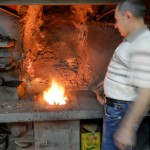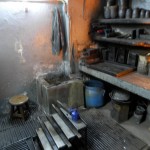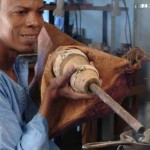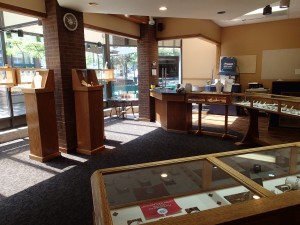Marjorie Elliott Bevlin, Design Through Discovery: The Elements and Principles, 2nd edition.
Monthly Archives: July 2014
“Design is, first of all, a plan for order.”
Quote
Marjorie Elliott Bevlin, Design Through Discovery: The Elements and Principles, 2nd edition.
Learning the Craft vs. Buying the Tool
We often say that jewelry making techniques haven’t really changed in thousands of years. Only the tools have been upgraded by technology. Sometimes, not even that is true.
I recently stepped back in time at least to the Middle Ages, if not to the time of the Pharoahs, when I entered a small jewelry-making shop on the second floor of the Grand Bazaar in Istanbul. As my eyes adjusted to the darkness, I saw that at the back of this brick-walled, stone-floored den was a raised hearth. On it was a bed of hot charcoal. On that rested a coil of gold. The metal worker, carefully watching the metal color and turning the coil with tongs, was annealing it in preparation for putting through the rolling mill being worked by two other men in
the center of the tiny space. (The only concession to modernity I saw was the mill.)
When the coil reached the right color—easily seen in the dim light—he picked it up and dropped it into a stone trough of water in the corner. Then he fished it out, tossed it onto the stone floor at the feet of the fellow feeding another coil through the mill. He added a bit of charcoal to his fire, and began heating another coil.
Then the other day, I read a post on Christine Dhein’s Green Jewelry News website, about her plan to travel the world learning about sustainable jewelry practices. In it, she described the work of Elhadji Koumama, a Tuareg craftsman from Niger, Africa. With–to our eyes–incredibly basic tools (making molds and crucibles out of donkey dung is pretty basic), Koumama makes really beautiful jewelry.
So why do I bring this up?
Many jewelry makers—no, many craftspersons—get a bit crazy about tools. (I know this. I paint.) They look for the perfect gizmo or widget that will allow the work to make itself. They argue about how buying the less expensive hammer from hither or the more expensive pliers from yon can affect their work. When you see jewelry produced with a goatskin bellows or a bed of charcoal, however, the arguments seem a bit hollow.
The reason, said Michael David Sturlin, as we strayed from the topic in a recent interview for Lapidary Journal Jewelry Artist magazine, is because “People want to make things, but they don’t want to learn how to properly make the thing before they start.” They don’t want to put in the—let’s face it—frustrating time to gain the skills necessary to make a high-quality final product. (Everyone who quit piano lessons in elementary school because they had to practice, raise your hand.)
Makers working in ancient traditions who do not have access to phone-book-sized tool catalogs often have a very high level of skill, said Sturlin, because they have a dedication to the craft that can be absent here. “The fewer tools they have, the more skilled they tend to be,” he said. In fact, he believes, “too many tools can be an impediment to achieving fluency in working with the material.” Like a musician or dancer, he explained, you have to invest the time in learning how to use the tool, use it correctly and learn how to do all that it will do for you.
I guess that means there isn’t a brush out there that will paint landscapes for me.
The Importance of the Right Tools
When was the last time you really looked at the condition of your store? Are the display pads worn or dirty? The cleaning cloths you wield every day threadbare? Does your staff argue over who gets to use the one millimeter gauge that is still legible? Is the bulb in your microscope burned out and still unreplaced? Is the equipment on your repair benches old, worn, taped together?
Your store and its reputation is made from more than the jewelry you sell and even the quality of your sales staff. The jewelry in your cases may be exquisite, but if you don’t have the right tools and equipment to support the sale of that jewelry, its beauty may dim in the eyes of customers–along with your reputation.
Attractive, clean, co-ordinated displays attract customers to your windows. But they do more than make your jewelry look terrific. They show customers that you care about your store and–by extension–them. Neat or even classy displays also give your employees a subliminal boost of pride in the store. They feel better about what they have to sell and it shows. Your business can only benefit from the resulting lift in confidence–on both sides of the counter.
When jewelry was still a gift only the wealthy could afford, presentation boxes were almost as impressive as the jewelry itself. Presentation boxes should still say a great deal about the importance of a gift of jewelry. There are many choices jewelers can make that go far beyond a cardboard box lined with cotton. Imprinted with your store name or logo, in your store’s colors, the box itself is a constant reminder to the recipient of where they can get concerned, informed, professional care of their special gift. And perhaps purchase a beautiful companion piece.
The tools your sales associates use when showing merchandise affect the impression your customers take away from your store as well. Loupes, tweezers, cleaning cloths, ring sizers should be professional and clean. There should be as many as needed around the store so that no one has to excuse him or herself to go searching. Well-prepared, well-equipped sales associates can turn all their attention to their customers instead of struggling with bent tweezers. The better they look the better you look, and the more confidence your customer has in your business.
While your customers may never see your office, appraisal desk, or repair workshop, the quality of the tools in those locations makes itself felt in the quality of the work produced in them. It is important to have good, up-to-date computer and bookkeeping systems for Internet searches, e-mail, repair tracking, and invoicing. Legible, well-organized appraisal and take-in forms guide staff though the process, preventing embarrassing–and possibly costly–omissions and errors. Well-maintained testing and gemological equipment ensure the accuracy of identifications as well as allow sales associates to examine carefully the jewelry they take in for repair.
In the repair shop, the quality of tools not only affects the quality of the workmanship, it affects the safety with which those tools are used. A saw frame or file with a loose handle makes for inaccurate work and puts the hands of the jeweler at risk. Injuries result in lost time and money–a good reason to see that every bench jeweler has the appropriate safety equipment and works according to well-understood safety guidelines. The condition of the shop, too, is important, especially if it is open to viewing by the customer.
The quality of the tools you use in your business–even those that are out of sight–is affects the way your business is perceived by your customers. It is reflected in the attitude of your staff toward their work and your product, and in your ability to offer quick, accurate, consistent, professional services that inspire trust and confidence. Be sure that you have everything you need–from drill bits, abrasives, and casting equipment to gem cleaning cloths, computer systems and packaging–that will help you keep your reputation as glitteringly beautiful as the jewelry you sell.







